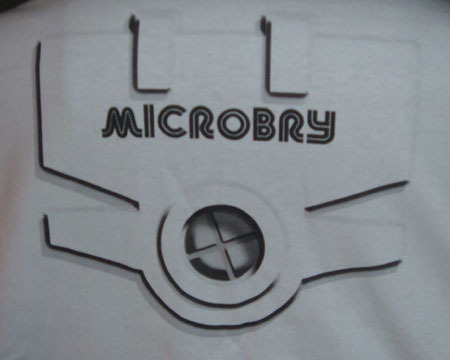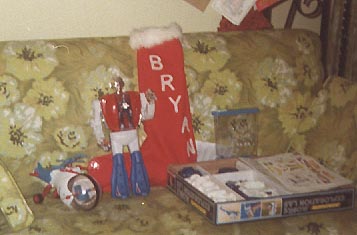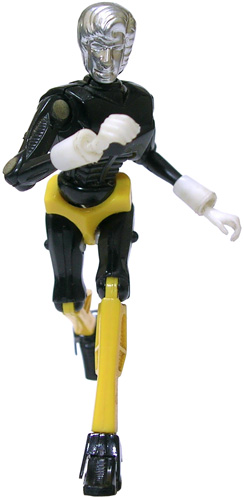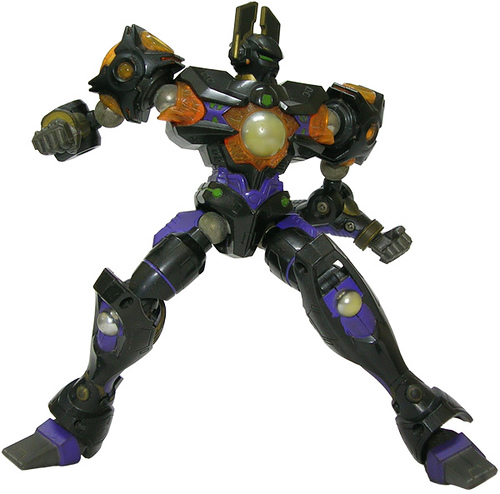Fanmode interview: Bryan Wilkinson (part 1)
Long-time Micronauts and Microman fan, Bryan “MicroBry” Wilkinson, is one of the select few who’ve made the transition from toy fan to toy designer. His website was one of the earliest to draw attention to Transformers’ (then) little-known origins, and he was given the opportunity to work on Palisades’ Micronauts revival in 2002. As Transformers celebrates its 25th. anniversary and Microman celebrates its 35th., we thought it only appropriate to ask him about Micronauts, Microman, Transformers, fandom, and making the transition from consumer to creator.
(Due to its length, the interview will be presented in several parts.)
Who is MicroBry?
I’m a toy collector (and occasional toy designer) in love with 10 cm, 3¾ inch or 1/18th scale toys using sci-fi themes, focused mostly on Microman and Micronauts.
I grew up in the 70’s with the Micronauts toyline and comics. Living in the culturally diverse San Francisco Bay Area allowed me to meet Japanese-American kids who knew the “secret origins” of the toyline (along with the shows I enjoyed such as Battle of the Planets and Starblazers) and they piqued my interest in Japanese toys and anime. As I grew older, Mego Corporation went bankrupt and the Micronauts toyline evaporated, so I began to seek out the original Japanese Microman series along with more Japanese anime.
Later the first Micronauts and Microman websites started to appear and a small internet community of fans began to connect together. I found one circle of Japanese collectors and artists (“MicroGeneration“) that were starting to make their own Microman-inspired garage kits. Since I knew a little bit of Japanese by then, I took a gamble and introduced myself to them and became involved tangentially. When I did so, I called myself “MicroBry” to introduce myself, as I wanted to express that I was a foreign Microman fan. The nickname has stuck with me ever since.

Photo copyright © Bryan Wilkinson. Used with permission.
(T-shirt design by Eric Wilkinson.)
How did you discover Micronauts?
It was the commercials in Mego’s first advertising blitz that caught my attention, probably before I even saw Star Wars. I would have been about seven at the time.
Micronauts debuted at Toy Fair in late 1976. In fact it was because Mego was negotiating with Takara for the series (which Takara had been producing since 1974 as Microman in Japan) that the representative from Fox assumed that Mego would not be interested in a second space-themed toyline and went to Kenner with the Star Wars property instead.
Mego, learning about this state of affairs later, pushed the Micronauts commercials out around the same time as Star Wars’ release–well before Kenner had any product ready themselves–to ride the new wave of sci-fi enthusiasm. They even did a commercial aimed at parents that promoted Micronauts as more an “educational toy” (like a mix of Capsela and Lego).
Why did you find the toys appealing?
The toys were flashy, futuristic, and unlike anything else out at the time (though soon to find company on shelves with Shogun Warriors, Star Wars, and Battlestar Galactica toys among others), and were clearly designed to be interchangeable to build original toys. While the toys looked cool and mysterious in their packaging and commercials, this factor only increased when handling the actual toys.
There were few if any other toys in this size format just yet. (Takara’s Ogawa Iwakichi innovated the 10 cm size [3¾ inch scale] format along with O-ring construction for the original 1974 Microman series.) While the chrome heads and plastic colors look strange today, there really wasn’t anything to compare it to yet, and most small scale figures then (for example, plastic army men) lacked much in the way of detail.

Copyright © Bryan Wilkinson. Used with permission.
The 1/1 scale of the toys makes them displayable in any environment, while at the same time the shared format with 1/18th scale allows for “toyjacking” from other lines, mixing, and potential for dioramas and so forth. You can view them in either scale as suits your preference or mood.
The interchangeability, largely due to the 5mm joint system (which Takara took inspiration from Lego), larger 10mm joints on the bigger toys and 3mm on newer ones as well as Magnemo magnetic joints, all gives a huge amount of flexibility for creating original toy recipes or parts-mixing across lines which use the same joints.
No backstory or explanation was provided. Rather than play off a licensed series, these toys were deliberately ambiguous. (In some ways, it’s not surprising at all that they would eventually be largely forgotten in the face of huge character-driven properties.) Most of the Micronaut figures came with names that were more designations rather than character names, adding along with the metallic-looking heads to the sense that these were not so much individual characters but unnamed toy soldiers of different types–“Space Glider“, “Galactic Warrior“, and so on. Their mysterious unknown “purpose” gave my imagination plenty of room to explore and questions to ponder.
What were your first Micronauts?
My first Micronaut toys were a blue Time Traveler, a Hydrocopter, a Mobile Exploration Lab, and Biotron.

Copyright © Bryan Wilkinson. Used with permission.
The Time Travelers, the most basic (and cheapest) figures in the toyline, had the same chromed head and were cast in eye-catching translucent colored plastic, but each had different colors and different modules that plugged into their abdomens.
(These parts were designed by Kobayashi Dan, who aside from doing similar work on Henshin Cyborg, is known best for the eponymous robots of Gaiking and Danguard Ace.)
These modules were abstractly electronic or mechanical in appearance and when removed, revealed a gaping cavity filled with molded circuitry suggesting transistors and diodes. Furthermore, a large 5mm socket was in their back (used for fastening the figures into seats of vehicles, etc.) with more mechanical looking detail around it, suggesting it was some sort of electronic socket or interface.
The aptly-named Biotron in particular reinforced the theme of cybernetics as it was a big, reconfigurable motorized robot toy that had a cockpit for a figure. Inside the cockpit were molded “electronics” (rather than controls) that led to a plug that fit into the socket on the figure’s back. The Time Traveler fit inside in a standing position, and the implication was obvious that Biotron could be controlled by the figure as an extension of their body, like a big exo-suit.
The Hydrocopter was a pretty straightforward, if cleverly designed, amphibious motorized vehicle toy (designed by Gundam designer Okawara Kunio), and the M.E.L. was more a playset that could be reconfigured in all sorts of ways, while its name implied it was some sort of research and exploration craft ideal for playing out missions.
All the toys in the line used these 5mm parts and were fully interchangeable, so it quickly became clear how much potential there was to be unlocked by collecting the series.
Why was Micronauts halted?
Micronauts did quite well against wave after wave of Star Wars toys, Shogun Warriors and others, but the toyline drew to a halt in 1980 due to Mego’s other problems.
After missing the chance for Star Wars, Mego bought every sci-fi license they could get their hands on for a while, and all of them were bombs except Buck Rogers. They were stuck with a lot of unsellable product and the various problems that ensued from that left the company bankrupt in 1982.
However, as Micronauts was the only toy line I really focused on while growing up (mostly because of the parental mandate to “stick to one series!”), I continued to seek out more to fill the holes–both in my collection and in my knowledge about them.
Mego’s factory, Lion Rock, tried to continue to sell some remaining Micronauts product for a few months longer, which left us with some interesting variants. An off-shoot of Mego attempted to rebrand some of the toys as a new toyline called “Lords of Light” that only lasted a short while, and the Lion Rock factory molds were later used in a brief licensing deal around the mid-80’s to do a recolored, renamed version of the Micronauts called “The Inter-Changeables“.
Italian company Gig soldiered on with the “i Micronauti” line for a while longer after Mego’s demise, and there appears to be some tie between the Inter-Changeables and Gig’s “Nuovi Micronauti” magnetic figures in the mid-80’s. Gig also did some spin-off toys from the line such as Fantanauti, Stellari Cavalieri as well as magnemo versions of superheroes and the robots from The Black Hole.

When did you first get into Microman?
My first Microman toy was a MicroChange Watch Robo, which I got in 1983. I didn’t know it was a Microman toy then, though the packaging had me wondering.
When Transformers came out, the first ones I got were the cassettes, and their size (the animals seemed the same scale as Micro’s and they all had 5mm pegs and sockets) and the memory of seeing them in the materials that came with the Watch Robo made me more suspicious. There were a pair of recognizable Microman figures in one tiny picture with the Watch Robo and other MicroChange toys, but I couldn’t read the Japanese, so it was still speculation. As far as I knew, the figures were just there randomly and not part of the same product line, or it was some strange crossover license. I didn’t know Takara as a company was responsible for Microman and wasn’t sure back then if Mego wasn’t originally Japanese or such.
It’s only when I got more interested in anime that I decided to try to learn Japanese kana and recognized the Microman logo. Then I finally noticed the same logo was on one of the old Mego toys: the “Time Chambers” that came with the Pharoid figures (but only the initial ones which were made in Japan rather than Hong Kong). I finally had my missing link, and a hint that Microman was still a going concern in Japan. I asked a friend’s parent who was going to Tokyo on a business trip for help, and she brought back what by ironic chance was one of the last two Microman toys made from the 80’s, the MicroChange MicroScope (later to become Perceptor).
I was particularly intrigued with learning the Japanese backstory and the idea that Microman could perhaps get its own anime series and/or move in a more “realistic mecha” direction, which Takara was exploring a little at the time.
Of course I had no idea that Takara was just then canning the series in favor of Transformers. I suppose it was lucky enough that Microman lasted the full 10 years it did in Japan. Still, knowing that Transformers was using Microman toys allowed me another way to collect Microman, and later still it was interesting to see the Microman and Takara SF Land legacy continue to influence Transformers design over the following decades.
I kept collecting Microman as I found them, but it was pretty slim pickings in the U.S. in the days before the World Wide Web, at least until the first licensed Microman revival series from Romando in the late 90’s.

In 1999, Takara brought back Microman and the Magnemo concept for an awesome toyline that lasted two years and had some of the best and most solid toy designs the series ever had seen, and then a couple years after that renewed the line as a collector-oriented figure line that further expanded its posability and diversity. Takara reimagined Microman not just as its own intellectual property, but also as a brand and figure format which would allow for marketing both licensed characters as well as blank figures for customizing, and they kept it going up through last year (and are now making plans for a possible new line).
And along the way, in 2002, there was the brief Micronauts revival from Palisades and Devil’s Due, too. It seems like every time I think things are starting to get a little less interesting, something new would pop up.
In part two of the interview, MicroBry talks about online fandom.
